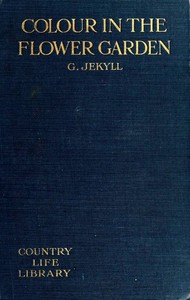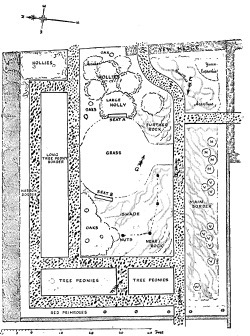Archive.org has a host of old gardening books (from mid-19th to mid-20th Century) available in many formats and on a host of topics. I happened across a few in my Pinterest feed and gone completely down the rabbit hole in this treasure trove of information. Sure some ideas might be out of date, but you never know what you might find when you explore these books. I’ll be sharing more books as I find them in the coming weeks. –Douglas
Historical Garden Books: Colour in the flower garden by Gertrude Jekyll – 8 in a Series
Download in EPUB, Kindle, Text, PDF, Single Page JPG, TORRENT from Archive.org
INTRODUCTION
To plant and maintain a flower-border, _with a good scheme for colour_, is by no means the easy thing that is commonly supposed.
I believe that the only way in which it can be made successful is to devote certain borders to certain times of year; each border or garden region to be bright for from one to three months.
Nothing seems to me more unsatisfactory than the border that in spring shows a few patches of flowering bulbs in ground otherwise looking empty, or with tufts of herbaceous plants just coming through. Then the bulbs die down, and their place is wanted for something that comes later. Either the ground will then show bare patches, or the place of the bulbs will be forgotten and they will be cruelly stabbed by fork or trowel when it is wished to put something in the apparently empty space.
For many years I have been working at these problems in my own garden, and having come to certain conclusions, can venture to put them forth with some confidence. I may mention that from the nature of the ground, in its original state partly wooded and partly bare field, and from its having been brought into cultivation and some sort of shape before it was known where the house now upon it would exactly stand, the garden has less general unity of design than I should have wished. The position and general form of its various portions were accepted mainly according to their natural conditions, so that the garden ground, though but of small extent, falls into different regions, with a general, but not altogether definite, cohesion.
I am strongly of opinion that the possession of a quantity of plants, however good the plants may be themselves and however ample their number, does not make a garden; it only makes a _collection_. Having got the plants, the great thing is to use them with careful selection and definite intention. Merely having them, or having them planted unassorted in garden spaces, is only like having a box of paints from the best colourman, or, to go one step further, it is like having portions of these paints set out upon a palette. This does not constitute a picture; and it seems to me that the duty we owe to our gardens and to our own bettering in our gardens is so to use the plants that they shall form beautiful pictures; and that, while delighting our eyes, they should be always training those eyes to a more exalted criticism; to a state of mind and artistic conscience that will not tolerate bad or careless combination or any sort of misuse of plants, but in which it becomes a point of honour to be always striving for the best.
It is just in the way it is done that lies the whole difference between commonplace gardening and gardening that may rightly claim to rank as a fine art. Given the same space of ground and the same material, they may either be fashioned into a dream of beauty, a place of perfect rest and refreshment of mind and body–a series of soul-satisfying pictures–a treasure of well-set jewels; or they may be so misused that everything is jarring and displeasing. To learn how to perceive the difference and how to do right is to apprehend gardening as a fine art. In practice it is to place every plant or group of plants with such thoughtful care and definite intention that they shall form a part of a harmonious whole, and that successive portions, or in some cases even single details, shall show a series of pictures. It is so to regulate the trees and undergrowth of the wood that their lines and masses come into beautiful form and harmonious proportion; it is to be always watching, noting and doing, and putting oneself meanwhile into closest acquaintance and sympathy with the growing things.
In this spirit, the garden and woodland, such as they are, have been formed. There have been many failures, but, every now and then, I am encouraged and rewarded by a certain measure of success. Yet, as the critical faculty becomes keener, so does the standard of aim rise higher; and, year by year, the desired point seems always to elude attainment.
But, as I may perhaps have taken more trouble in working out certain problems, and given more thought to methods of arranging growing flowers, especially in ways of colour-combination, than amateurs in general, I have thought that it may be helpful to some of them to describe as well as I can by word, and to show by plan and picture, what I have tried to do, and to point out where I have succeeded and where I have failed.
I must ask my kind readers not to take it amiss if I mention here that I cannot undertake to show it them on the spot. I am a solitary worker; I am growing old and tired, and suffer from very bad and painful sight. My garden is my workshop, my private study and place of rest. For the sake of health and reasonable enjoyment of life it is necessary to keep it quite private, and to refuse the many applications of those who offer it visits. My oldest friends can now only be admitted. So I ask my readers to spare me the painful task of writing long letters of excuse and explanation; a task that has come upon me almost daily of late years in the summer months, that has sorely tried my weak and painful eyes, and has added much to the difficulty of getting through an already over-large correspondence.
More information on this book:
Learn more about gardening history with these books
* A portion of each sale from Amazon.com directly supports our blogs
** Many of these books may be available from your local library. Check it out!
† Available from the LA Public Library




